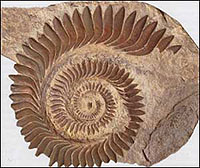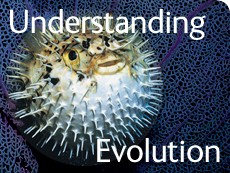Jaws: The natural history of sharks
Michael Bright
The world before 'Jaws': Shark evolution
The origin of sharks is even more obscure than that of most other groups of animals, for they have left very little evidence of their existence. Since their skeletons consist of cartilage rather than bone, the only early shark fossils we have are those of dermal denticles, teeth, spines and the occasional skeleton, preserved under exceptional circumstances.
The oldest shark-like creatures appeared in the fossil record towards the beginning of the Silurian period, about 450 million years ago, but the earliest known fossil teeth of true sharks do not appear until the Early Devonian, about 400 million years ago. Their teeth are small, no more than 4 mm (0.16 in) across, so their owner may have been no more than 30 cm (12 in) long. The skeleton of such a creature, a common ancestor for all the sharks and their relatives, has yet to be found. A candidate for close relative, however, is Antarctilamna, whose fossils have been found in rocks on the Antarctic continent. This fish was just 40 cm (16 in) long, and distinctly shark-like. It had a spine in front of a long dorsal fin, and teeth that had two large splayed cusps, with smaller cusps between them.
The age of fish

These fossil teeth of an ancient sand tiger shark Odontaspis robusta were found in Kent, England. Their owner lived in the early Eocene epoch, about 50 million years ago. The slender teeth are from the front of the mouth and the broader-based ones are from the side.
The first major radiation of sharks occurred in the Devonian period. This was the 'age of fishes'--a time when all fishes, including sharks, diversified greatly. One of the earliest true shark skeletons to be found intact was that of Cladoselache. Intact fossils of ray-finned bony fish have been found in the stomachs of some individuals, their orientation indicating that they were taken tail-first, so Cladoselache must have been quite capable of outswimming its prey. It also grubbed about on the sea bed. About 25 per cent of specimens so far recovered had been feeding on the blind, shrimp-like crustacean Convaricaris, which buried its head in sediments on the sea bed and fed on the dead bodies of fish and squid.
Cladoselache and other sharks living in those Devonian seas would have had to compete with the formidable armour-plated placoderm fishes. Yet, already the sharks had gained a tactical advantage with a body plan that was both simple and hydrodynamically efficient. With a pliable skeleton of cartilage that gave strength without weight, they were better adapted than their rivals and poised to go on to even greater things.
The age of sharks

While the earliest fossil sharks superficially resembled modern sharks, later species from the 'golden age of sharks' appeared in all manner of curious shapes and sizes. Top, Cladoselache; middle, Helicoprion; bottom, Stethocanthus. (Image: Philip Rye)
By the start of the Carboniferous period, about 360 million years ago, sharks diversified and proliferated to such an extent that scientists have labelled this the 'golden age of sharks'. In addition to the obviously shark-like species, there were some that can only be described as bizarre. Stethacanthus probably grew up to 3.4 m (11 ft) long and differed from any other shark, living or dead, in having a helmet of small teeth on its head and a curious structure shaped like a triangular shaving brush sticking out of its back, roughly where its anterior dorsal fin should be. This was topped by dozens of teeth, small ones at the front and larger teeth at the back, and was present in both male and female sharks. Such a conspicuous and awkward structure must have had an important function, but what this could have been can only be speculation. It may have played a role in courtship, had something to do with defence, or maybe it enabled Stethacanthus to anchor itself, like a modern remora, to the underside of a larger fish.

The tooth whorl from the fossil shark Helicoprion was at the tip of the lower jaw. The older teeth are at the centre of the whorl, which is about 20 cm (7.8 in) in diameter.
Helicoprion. The shark itself is poorly known, but the pattern of its teeth is instantly recognisable. They formed a whorl erupting from the back of a semi-circular 'conveyor belt arrangement', but the teeth did not fall away at the front as in modern sharks. Instead, they were rotated under the apex of the lower jaw, and then back up into a cavity under the jaw where they were stored in a tight spiral. Why these sharks possessed such a bizarre dental arrangement is another mystery.
There were giants, too. Enormous fossil teeth from a shark with a mouth a metre (3 ft) wide and a body 6 m (20 ft) long have been found in Lower Carboniferous deposits in North America. With the giant placoderms gone at the end of the Devonian, these enormous sharks would have been the largest vertebrate predators in the sea.
Falling and rising fortunes
In the late Carboniferous period, about 300 million years ago, the period of rapid diversification came to an end, and sharks lived through many millions of years with little evolutionary change. Then, there was a global catastrophe. At the end of the Permian period, about 245 million years ago, extensive volcanic eruptions, together with the resulting climate change and changes in sea level, caused about 96 per cent of marine life to disappear in the greatest mass extinction event of all time--and many of the vanishing species were food for sharks. Most types of sharks, some of which had become victims of their own specialisation, joined the casualty list, but a few survived and a second evolutionary jolt caused two main shark groups to fill the vacant ecological niches.
One group included the xenacanth sharks. They appear to have avoided extinction by moving into freshwater. One species, Xenacanthus, was a 75 cm (30 in) long, eel-like shark that resembled a modern conger eel. It had a dorsal fin that extended the length of its back and around the tail to join with an unusual double anal fin. Its most conspicuous feature was a single defensive spine growing backwards out of the top of its head.
The other survivors were in the sea. These were the hybodonts, unspecialised sharks that resembled modern sharks but were not their immediate ancestors. Their success demonstrated that the basic shark structure and way of life had evolved successfully tens of millions of years before modern sharks appeared.
By the start of the Jurassic period, 213 million years ago, the first 'modern' sharks were challenging the hybodonts. These newcomers had more flexible jaws that could be thrust forwards, giving them a distinct advantage in the competition for food. The hybodont lineage began to tail off, and sharks remarkably similar to modern species started to take over.
Modern sharks arrive
Medgalodon
The species Carcharodon (Carcharocles) megalodon, often known as 'megatooth' or megalodon, was a real giant, even larger than the whale shark, the largest living shark. An ancient relative of the great white shark, Megalodon was probably the most formidable predator ever to have swum in the sea, and one of the most dangerous animals ever to live on the planet.
Megalodon fossils are generally found in near-shore deposits, indicating it probably lived in the coastal regions of warm seas. The profusion of fossils of sea mammals, such as whales and dolphins, in the same rocks suggests there was an abundance of prey for it to feed on. Megalodon reached its greatest length and size during the Miocene, about 12 million years ago. The largest specimens were estimated to have measured about 16.8 m (55 ft) long, weighed 25 tonnes, and possessed an immense mouth with a gape of about 2 m (6 ft) that could swallow five adult humans in one gulp. Its jaws were lined with 15 cm (6 in) long triangular, razor-sharp teeth.
The Jurassic and Cretaceous periods were the 'age of reptiles'. In the sea, relatives of the dinosaurs included long-necked plesiosaurs and shark-like ichthyosaurs, but the new breed of sharks--streamlined, fast-swimming and equipped with their remarkable battery of senses--were strong competitors. Some were huge. The cretoxyrhinid sharks, for instance, were active hunters with lengths over 6 m (20 ft) and weights in excess of 1.5 tonnes.
There were also the ptychodonts, a group of sharks known only from their teeth. These were flattened, crushing structures, suitable for tackling hard-bodied creatures, such as ammonites, bivalves and gastropods. Cretaceous deposits also contain the teeth of what look remarkably like those of sand tiger sharks and there were the recognisable teeth of large lamnid sharks, relatives of today's mackerel sharks, from species that must have been over 6 m (20 ft) long. Fossil teeth from ancient porbeagles Lamna, for example, have been unearthed in rocks dating back to the Cretaceous.
That sharks arose at all is something of a miracle, for they began to evolve during a series of devastating episodes in the Earth's history that must have had an impact on sharks and their food. At the end of the Triassic period, another 20 per cent of marine families were hit badly by another mass extinction, and at the end of the Jurassic there was another minor event. Then, at the end of the Cretaceous, about 64 million years ago, about 70 per cent of all living things, including the dinosaurs and their relatives, were wiped out. It was an opportunity, however, for others to flourish, and some of the new sharks survived the catastrophe. There was a distinct loss of diversity in the groups, but the survivors were a tough, well-honed bunch.
These included great filter feeders, such as basking sharks Cetorhinus, straining the water for krill in the manner of modern baleen whales; also, tiny fossil teeth, closely resembling those from the mid-water filter-feeding megamouth Megachasma, have been found in Tertiary rocks. There were fast-swimming hunters, too, including a new group of sharks that would come to dominate the seas up until the present day. These were the carcharonids--the requiem sharks.
With the demise of the giant reptiles, the mammals began to fill some of the vacated niches, and some returned to the sea. The evolving whales, dolphins, seals and sea cows became the main source of food for one group of sharks in particular--the ancient relatives of the great white shark. The earliest fossil teeth resembling those of modern great whites were found in rocks about 65 million years old. Even at this early date, the great white's ancestors were poised in evolutionary terms to exploit the coming superabundance of blubber and meat, and some species took full advantage, including some of the most powerful predators known to have lived in the sea. Today, the last survivors are the great white shark and its close relatives the makos and porbeagles.
Toolbox

Until 1938 whale carcasses were buried in the Museum grounds so that their flesh would decay leaving only the skeletons.

